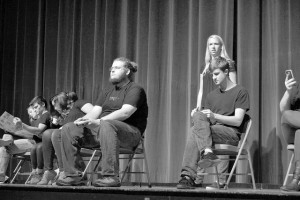
Students participate in an interactive play that demonstrates the influence of sexual harassment. (Photo by Kelsey Cherwinka)
Elizabeth Pulanco/Winonan
As a source of entertainment, theatre is often used to help people escape reality and forget about their normal lives.
Last week, as a part of Sexual Assault Awareness Month, Winona State University presented “When…,” a play about sexual assault and domestic violence.
Megan Rae, producer of the show, developed the interactive play that allows students to show how they would intervene and stop the escalation of these events.
To get Winona State students involved, Women’s and Gender Studies professor Tamara Berg promoted the show on campus.
“We advertised through some of the student clubs and we ended up casting students that were already involved with the RE Initiative,” Berg said.
The RE Initiative is a program at Winona State that helps educate people about gender-based violence and also provides services for victims of gender-based violence.
For Rae, the interactive play helped inform people about different ways to intervene.
“Changing the format into an interactive educational style creates a safe space to teach people how to become active bystanders,” Rae said.
Rae started writing the play in 2009 and used her experience as a public speaker to help create some of the material within the play.
“Victims would come up to me and talk about their experiences and what would be good examples to put in the show,” Rae said.
The play was split into three acts. Each act displayed a social error or problem. After watching the problem escalate, Rae stopped the scene and allowed the audience to discuss how they would intervene in the situation. After describing what their solution to the problem would be, the audience went on stage and acted out their suggestion.
The first scenario dealt with domestic violence between a married couple. The point of view in this scene switched from the victim, to the abuser and then to the people in their lives. Each character had a different solution for the victim, which made it difficult for her to make a decision.
Right as the victim began to break down, Rae stopped the scene and allowed the audience to give their suggestions. Since it was early in the show, the audience intervention portion did not occur yet.
The second scenario featured different kinds of publicly displayed violence. Within this scenario there were three different scenes. The first two scenes took place at a party and the third scene took place at a restaurant.
The party scenarios first involved a fight between two men and then a fight between two women. When the students acted out their suggestions, they had to find a balance between aggressive and passive. The audience interventions that prevented the fight between the individuals at the party were the ones that involved distracting the two parties or starting up small talk with them.
Distractions also helped mediate the situation at the restaurant, which showed a verbally abusive wife yelling at her husband. Rae ended the scene right before a possibly violent situation could have occurred. An audience member intervened in this scene by asking the wife for assistance in the women’s restroom. Once the wife left, another audience member asked the husband how he was doing.
The third and final scenario in the play dealt with sexual assault. During this scene, a young man started flirting with an already-drunk young woman. As he attempted to persuade her to leave with him, he kept serving her alcohol. While he was doing this, she said she wanted to go home.
Rae stopped this scene as the young man led the disoriented young woman upstairs. One audience member intervened in this situation by offering to walk the young woman home after she mentioned she wanted to leave. Another audience member offered to play a card game with the young woman, which distracted her and caused her to walk away from the young man.
Rae explained how even though there might not always be a perfect solution, it is always important to think of different ways to end bad situations.
“We’ve got to promote critical thinking about how a person can intervene in these situations in a positive and effective way,” Rae said.
Senior Madeline Mowery, who was in the play, also believes going over different ways of intervening is beneficial for the situation.
“It’s important to educate yourself,” Mowery said. “It’s good to know how to respond and help in situations.”
The importance of knowing about different intervention tactics increases after looking at statistics about sexual assault on campuses.
According to the National Sexual Violence Resource Center, “one in five women and one in 16 men are sexually assaulted while in college.”
When looking at Winona State and campus assaults, Berg sees strong cooperation within the university on dealing with these issues, but there is still work to be done.
“Just like every university around the country, we have issues with under reporting,” Berg said. “If you look at our annual security report over the past few years you will see zero sexual assaults reported on campus which we know does not reflect what students have experienced.”
The introduction of the RE Initiative and other educational programs show Berg Winona State is dedicated to taking action on concerns with sexual assault.
“We have developed a peer-led advocacy group that has reached thousands of students about bystander intervention,” Berg said. “There’s a great commitment by the university to work in a collaborative way on issues of gender based violence.”
By letting Rae present the play on campus and involving the campus community with the production, Winona State is bringing attention to and address this important issue.
For any students interested in joining the RE Initiative, email them at [email protected].







































